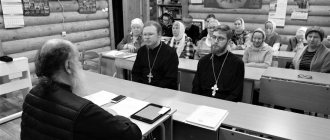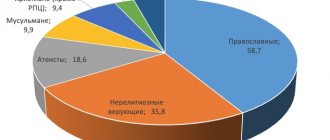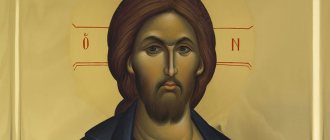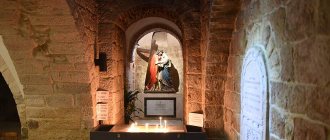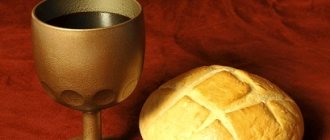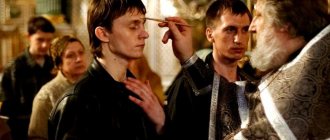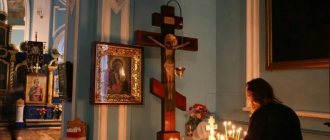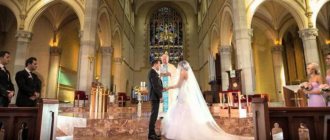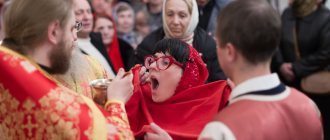New in blogs
Today’s message is devoted to the rather confusing scheme of the Orthodox priesthood, in which not only journalists, but also fellow religious scholars often make mistakes. In addition, in this message we will begin a topic that will be developed in the next post - about names in a person’s life and the connection of names with religion. The Orthodox clergy (aka clergy) is divided into two branches - white and black. White clergy, unlike black clergy, can marry and have children. Black, monastic clergy take a vow of celibacy.
Representatives of the white clergy begin with the rank of
deacon (Greek minister) (the lowest, first step; they cannot perform the sacraments and conduct the service independently). There are two honorary titles - protodeacon (Greek first minister) (the main deacon in the diocese, often granted as a sign of special merit, or after 20 years of blameless service) and archdeacon (Greek chief minister) (among the white priesthood this can only be the patriarchal deacon ). There is also an interesting precedent - for the only time in the history of the Russian Orthodox Church, Archdeacon K.V. Rozov, in honor of the 25th anniversary of his diaconal service and in commemoration of his merits, was given the unique title of Great Archdeacon (in 1921).
The subdeacon does not belong to the clergy - he is a senior clergyman who carries out auxiliary actions for a high-ranking priest; an intermediate link between clergymen (psalm-readers, bell-ringers, prosphora players, etc.) and clergy. After ordination, the priest becomes a priest (Greek priest), or presbyter (Greek elder) (also most often, by priest in the proper sense of the word they mean precisely this, the second level of the priesthood). He can perform the sacraments (except for ordination) and lead the service. There are also honorary titles. The first is the archpriest (Greek first priest) (usually the rector of the temple; in the old terminology - archpriest). Such a title is usually given as a reward no less than 10 years after ordination to the priesthood, and, in addition, it is possible to elevate a protodeacon directly to archpriest, bypassing the priestly rank. The second title - protopresbyter (Greek: chief elder) - is the highest rank available to the white clergy, and is currently awarded “in exceptional cases, for special church merit, on the initiative and decision of His Holiness the Patriarch.”
The black clergy - monks - begin the first step with the rank of
hierodeacon (Greek: sacred minister, i.e. a monk in the rank of deacon). A senior monk may bear the title of archdeacon as a sign of merit, often in large monasteries.
A monk of the second degree, ordained a priest, bears the rank of hieromonk (Greek: sacred solitary). Only from among the hieromonks is the abbot (Greek leader) - the abbot of the monastery - elected. There is also an honorary title - archimandrite (Greek chief of the monastery) (approximately equivalent to protopresbyter). Archimandrites most often become the abbots of the largest and most important monasteries, or persons occupying large church administrative positions related to the functioning of the monastery.
Only monks have access to the third, highest level of clergy—bishopricism (Greek: chief priest). It is bishops who can perform the sacrament of ordination, and calling them “priests” is terminologically incorrect. Jesus Christ himself is called by the Apostle Paul “a bishop according to the order of Melchizedek forever” (in the Epistle to the Hebrews).
The first rank of bishop is the rank of bishop (Greek: overseer). The bishop usually "runs" a region or diocese, although there are exceptions. Again, there is the honorary title of archbishop (Greek: chief overseer), which is most often awarded for merit, and in some cases to the head of a large diocese, although at various historical periods archbishops could lead entire churches. Thus, dioceses that include vicariates are almost always headed by archbishops. Another honorary title - metropolitan (Greek, located in the main city) - is assigned to the head of the metropolis - a large region (district) uniting several dioceses.
The highest rank of bishop is the rank of patriarch (Greek: chief father). Historically assigned to the most important bishops; then basically means the primate who heads an autocephalous (independent) church. The Patriarch of Moscow and All Rus' currently heads the Russian Orthodox Church, “has primacy of honor among bishops and is accountable to the Local and Bishops’ Councils.” In addition, the patriarchs are the primates of the Bulgarian, Georgian, Serbian, Romanian and some other churches (in particular, the Catholic metropolises of Venice and Lisbon!).
In addition, within monasticism itself there are degrees of initiation that determine the stage and depth of immersion in the monastic way of life.
Before being tonsured as a monk, a person must go through a stage of novitiate . No vows have yet been made; you need to prepare yourself for tonsure and get used to monastic activity. It is allowed to wear a cassock as clothing.
The next stage is tonsure, after which the person changes his name and becomes a ryassophore (wearing a cassock), monk or monk . The only vow he takes is the vow of obedience; he is allowed to wear a cassock and a hood with rosary. Since it is customary to ordain only monks as bishops, the ryassophore is already a sufficient degree for episcopal ordination (subject to acceptance of celibacy) - in contrast to the Greek tradition, where the ryassophore retains a secular name and is free to return to ordinary life.
After this, the monk can accept the small or mantle schema. He changes his name again, becomes a monk in the full sense of the word, and takes the following vows - obedience, celibacy, non-covetousness and unceasing prayer. You need to choose an elder - a spiritual mentor, whom you should obey. In addition to this, the monk is assigned certain prayer rules, and he is obliged to carry out monastic service. A monk, in addition to his previous attire, may wear a tunic, a paraman (a square with inscriptions and a cross) and a pallium mantle.
Finally, a monk can accept the great schema and become a schemamonk, schema-monk , or monk of the great schema . His name is changed again, he takes special vows and usually lives separately from the brethren. It is schemamonks who usually perform the highest monastic feats, and they are called accordingly: hermits, hermits, hermits, stylites. Schemamonks, in addition to the previous clothes, wear special paramans and a doll hood.
A schemamonk who has the rank of priest is called a hieroschemamonk . An archimandrite who has accepted the schema is called a schema-archimandrite .
I hope that now the system of Orthodox titles has become easier to understand! If necessary, you need to make a suitable diagram to show how the “development” is going along one or another path of the cleric (leveling up, yes xDD)
It is interesting that with each new name change, the monk seems to die for the old world and is born again, and at the same time, more and more new intercessors appear for him. This tradition is characteristic not only of monasticism, and we will talk about names, naming and choosing pseudonyms in the next post. Thank you for attention!
Where His Holiness rests his soul
— Does His Holiness have any favorite places for prayer retreat, places where he feels at home?
— The Patriarch loves to come to Solovki. Now there, monastery life is gradually being revived, including through his care and concern. His Holiness loves Valaam very much, just as the late Patriarch Alexy loved this island.
I think Smolensk and Kaliningrad occupy a special place in his soul.
His Holiness greatly reveres the Smolensk Icon of the Mother of God, which is located in the Smolensk Cathedral. He said more than once that this was the first shrine that he met upon his arrival in Smolensk from St. Petersburg, then still Leningrad.
And, of course, Kaliningrad is very dear to his heart.
- Yes, for so many years at the department...
“It’s not even a matter of how many years His Holiness spent in this department.
The Kaliningrad diocese, in the literal sense of the word, was created by his hands, because before his appointment there there was not a single Orthodox church there at all. No one! It was a completely atheistic region of the Soviet Union, a spiritually scorched earth.
When Archbishop Kirill arrived there and came to the Commissioner for Religious Affairs in order for the dioceses to hand over the destroyed church building, they told him: “Yes, we are giving this church to you,” and behind his back they added: “We haven’t given this church up for forty years, now It will take you another forty years to restore it.”
And now we see an absolutely incredible picture: diocesan life in full swing, churches, children, youth - it seems that it has always been like this here, while all this was created by the hands of the Archbishop, and then Metropolitan Kirill during his 25 years of stay in Smolenskaya department Of course, this makes a very strong impression.
Figure in many scandals
The personal life of Patriarch Kirill does not provide as much food for gossip as the professional activities of the hierarch. Let's look at several high-profile cases in which the Vladyka was involved.
- In the early 90s, taking advantage of church tax benefits, Metropolitan Kirill established profitable imports of tobacco and alcohol products. In response to an investigation by Novaya Gazeta journalists, the church stated that this was an attempt to discredit the name of the man of God.
- Having taken monastic vows, Cyril also took a vow of non-covetousness. In 2012, the press service of the Russian Orthodox Church released a photograph in which the patriarch’s wrist was adorned with a watch from the French company Breguet worth more than 30 thousand dollars. Later, the picture was unsuccessfully photoshopped: the watch on his hand was removed, but the reflection in the varnished surface of the table remained. This sparked a wave of internet memes and ridicule. In the end, the editor returned the clock to its place.
- The scandal continued in 2022. Barnaul resident Andrei Shasherin was charged with “extremism” (Article 282 of the Criminal Code of the Russian Federation) for posting a cartoon on his VKontakte page. In the picture, Christ asks Kirill what time it is, and he demands to leave him alone. Shasherin was released in January 2022 due to the partial decriminalization of the article.
- The Breguet watch, as well as the apartment in the famous House on the Embankment, is not the only personal property of the patriarch. Expensive luxury yachts, private jets and cars are regularly captured by the press. In addition to the Moscow penthouse, Gundyaev owns a residence in Crimea. For the construction of the latter, a relict forest near Gelendzhik was sacrificed. Now the residents of the town are cut off from the sea and the village cemetery.
- The Church calls on the faithful to forgive their enemies. But Kirill, in response to the performance “Virgin Mary, drive Putin away” by the punk group Pussy Riot, said that the church will not forgive blasphemy. The girls were given 2 years, which served as a precedent for amending Art. 148 of the Criminal Code of the Russian Federation, according to which “insulting the feelings of believers” faces criminal liability.
- Patriarch Kirill also found himself at the center of international scandals. In March 2022, the hierarch arrived at events celebrating the 140th anniversary of the liberation of Bulgaria from the Ottoman yoke. The Patriarch did not like the speech of the President of the country Rumen Radev, in which he said that different peoples took part in the fight against Turkey. Gundyaev said that Radev humiliated Russia by reducing the country's role in the liberation of Bulgaria.
- In response, Bulgarian Prime Minister Valery Simeonov said that it was not for the “cigarette metropolitan” or the “second-rate KGB agent” to dictate what the head of state should say. Diplomats of the two countries made a lot of efforts to neutralize what the Bishop said and establish friendly relations. However, Bulgaria voted to continue sanctions against the Russian Federation.
- Kirill’s statements against Ukraine are a separate chapter. The hierarch repeatedly spoke about the Civil War in the neighboring country. The provision of the Tomos to the Ukrainian Local Orthodox Church by Patriarch Bartholomew of Constantinople infuriated the Bishop.
- In his hearts, the hierarch declared that he did not see the possibility of the Russian Orthodox Church being in Eucharistic communion with the Patriarchate of Constantinople. This deprives Orthodox Christians in Russia of the opportunity to venerate the relics brought from Byzantium.
Photo with the reflection of the patriarch's watch, which caused a scandal
Education
The development of Volodya, as well as the hero’s brother and sister, was influenced by his grandfather returning from Solovki. A true religious dissident, the old man said that he never caved in to the current government, considering God to be the supreme authority.
Vasily Gundyaev - grandfather of Patriarch Kirill
Vladimir, according to the patriarch, was not a member of either the pioneers or the Komsomol. “When the school director insisted on joining the pioneers, I said: “Okay, I’ll wear a red tie. But know that I will go to church in it too!” - this is how Patriarch Kirill talks about his school years.
It is strange that the confrontational teenager was not expelled from school. The boy studied well. The student was especially good at exact sciences, mathematics and physics. After studying 8 classes at school No. 2, Vladimir switched to the evening department so as not to burden his parents.
The young man got a job as a cartographer in the Leningrad geological expedition. Since 1965, Gundyaev received theological education. The guy entered the Leningrad Seminary, and in 1967 continued his studies at the Theological Academy of the City on the Neva.
All the children of priest Mikhail Gundyaev devoted themselves to the church. Vladimir's elder brother, Nikolai, became an archpriest, rector of the St. Petersburg Theological Academy of St. Petersburg, and also rector of the cathedral. Elena, the youngest in the family, took the post of headmistress of the Orthodox gymnasium, vice-rector for culture and head of the regency department of the same theological academy.
Vladimir Gundyaev – rector of the Theological Academy
